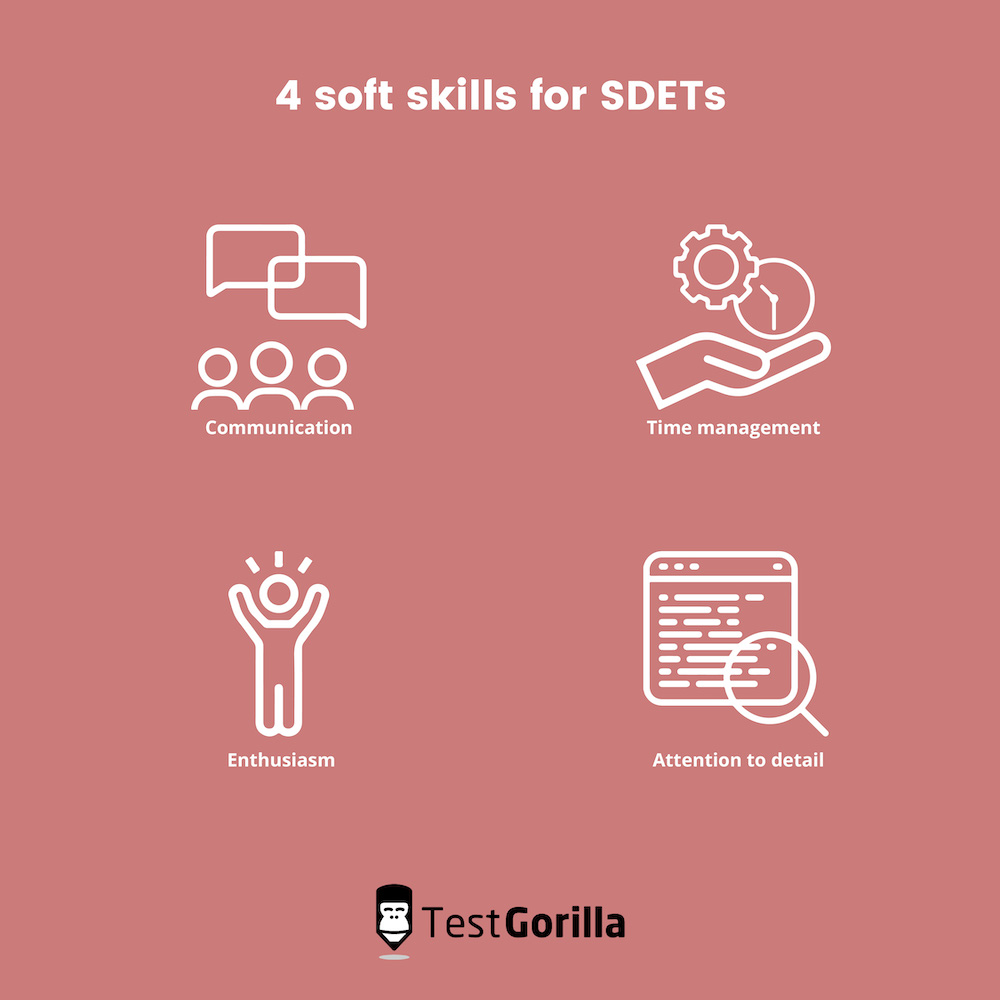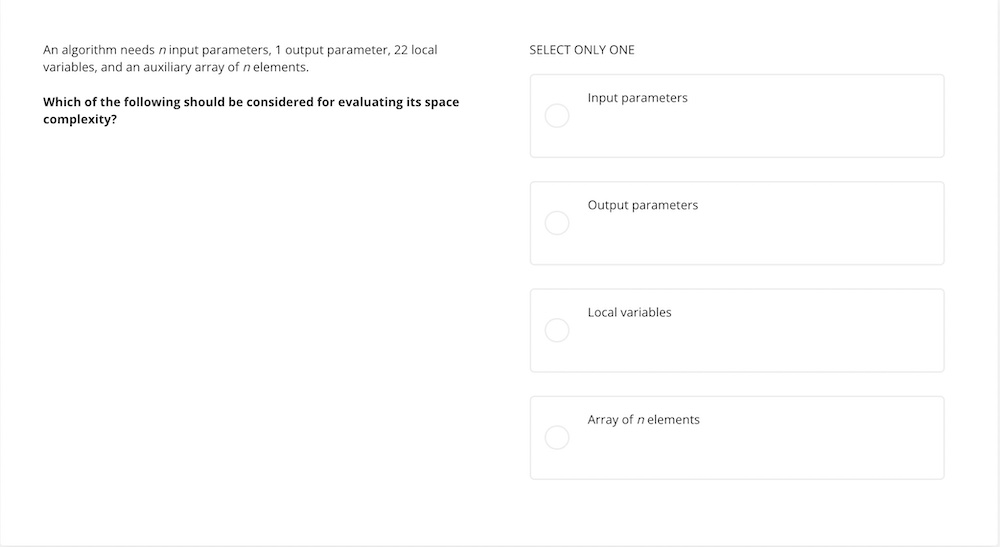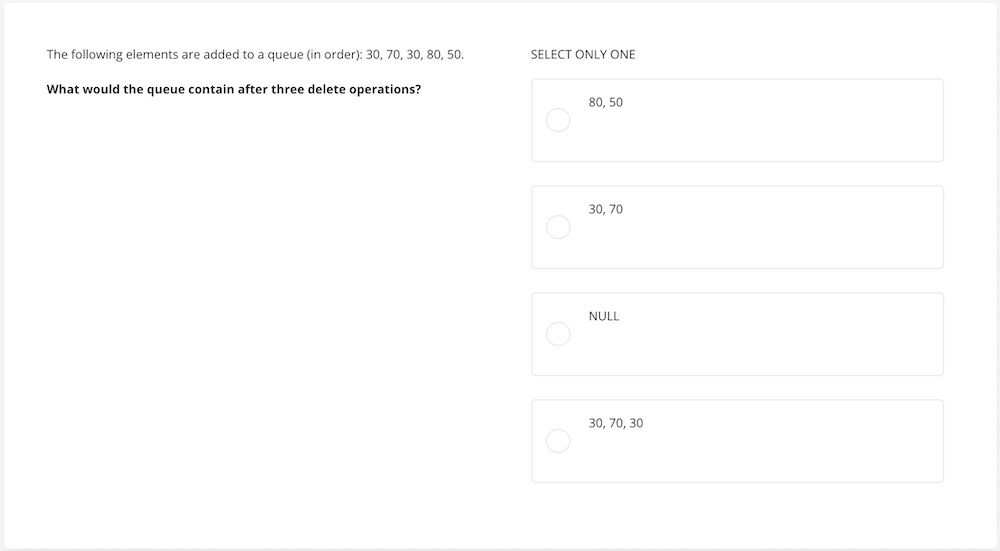Technology is evolving all of the time.
To keep up, IT professionals need to actively acquire new skills that are relevant to their field. This is especially true for software engineers: From writing code to testing and debugging it, software development practices are evolving at a lightning-fast pace.
SDET stands for software development engineer in test, and it’s one of the most multi-skilled roles out there. Because skilled SDETs have such a wide skill set, hiring them is one way for companies to build healthy development ecosystems with fewer people. It’s a challenging role to fill; recruiters can have a hard time finding someone with the right balance of technical skills and testing knowledge.
It’s common to put this down to a knowledge gap – a discrepancy in the skills required by employers and the skills candidates can offer. But there’s another culprit at play that often gets overlooked: CV- and resume-based hiring practices.
These traditional recruitment methods are an obstacle to employers. They favor education and experience over real skills and knowledge, and entire talent pools get cut off even though they might contain great candidates.
Pre-employment testing is the solution. Are you looking for a talented SDET but struggling to find the right candidates? Read on to find out which skills to look for and how to build an assessment for the software engineer in test role.
Table of contents
The software engineer in test (SDET) role explained
SDETS work at the intersection of software engineering, software testing, and quality assurance. They test technical software with an emphasis on developing automated test scripts that can help teams reduce repetitive efforts.
Because they work in software development as well as testing processes, SDETs should be proficient in both.
Why do organizations need them?
Software is no good if it’s not high quality. And to ensure it’s high quality, you have to test it. All the time.
Testing is essential for businesses and organizations if they want to deliver high-quality products and services. They need a strategy that ensures all areas for improvement are covered but that is also realistic. Highuality is achievable, perfection is not.
Quality is not an act, it is a habit
Aristotle
Quality assurance is important in every single industry. The things we use every day have likely all been through a quality assurance process of some kind, from the shoes on your feet to the veggies you pick up at the supermarket.
For companies that build with software, rather than shoe soles and plant matter, these processes can get pretty technical. Every product has a few core features that must be functioning every time the product is released.
This means that for every sprint existing functionalities, as well as any new features, must be tested. That’s a lot of testing.
For developers working in agile environments, sprints are pretty short. They tend to be around two weeks long, so often testers don’t have enough time to do all the testing manually. If a team doesn’t have the skills required to write automated test scripts, you can see how things might get sticky. This is where SDETs come in.
Hiring SDETs and placing them in agile teams is the best way to prevent testing from becoming a bottleneck in the pipeline from software development to product release. Organizations need SDETs because they have the skills to alleviate the time and resource burdens of manual testing.
SDETs differ from QA engineers
With all this emphasis on testing for quality, you might be thinking about how similar this role sounds to what a quality assurance (QA) engineer does. There is, however, a key difference.
An SDET is skilled in development and testing, whereas QA engineers and testers are just involved in testing manually or by automation. They focus on testing so their programming skills are limited, but SDETs are highly proficient coders.
SDET roles and responsibilities
In a nutshell, a software development engineer in test can do the following for businesses:
Automate acceptance test scripts by leveraging their coding skills, saving time and resources
Individually build, deploy, manage, and run applications
Inform the design and development of technical implementations and user scenarios
Continually review products and services to update requirement specifications
Daily tasks of a software engineer in test include:
Participating in development
Writing test scripts and performing tests
Fixing bugs
7 technical skills for a software engineer in test
Because an SDET is a fusion of software developer and test engineer roles, it’s a job that requires skills from both camps. Here are seven technical skills to look out for.
Computer science fundamentals
Computer science (CS) is the study of computers and algorithmic processes, including their principles, their hardware and software designs, their applications, and their impact on society
Iowa Department of Education
Knowledge and understanding of the fundamental computer-science concepts is at the foundation of any successful SDET’s skill set. These fundamental concepts include:
Discrete mathematics, including sets, boolean logic, number theory, probability, algebra
States and state machines, state transitions, stateful and stateless design, soft states
Instruction and sequentiality
Data input and output, encoding and decoding, encryption and decryption
Data and information security
Coding processes and errors
Mathematical logic is at the core of computer science, and its fundamental concepts branch out from this. Knowledge of these concepts feeds into all of the skills below.
Programming languages
An SDET should be familiar with at least one major programming language and should understand coding processes and best practices. Their knowledge should extend to object-oriented programming concepts, frameworks, concepts, and algorithms – often the fundamentals of one language can be applied to another.
Data structures
A data structure is just a way of organizing data in a computer. The way data is arranged affects what it can be used for and how, so data structures are designed to suit a specific purpose. They enable ease of access for users, helping them work with the data they need.
Data structures are used in almost every program or software system that has ever been developed, and there are generally four types.
Linear data structures
Trees
Hash-based structures
Graphs
They’re used widely across the fields of computer science and software engineering, so SDETs should know about the most commonly used data structures and be able to use them effectively.
Algorithm analysis
Algorithms solve problems. They provide a list of specific instructions that, when followed, conduct a series of actions step by step. Once all instructions, or inputs, have been followed by the computer, you get a result, or output.
Algorithms are important because they offer a step-by-step representation of the solution to a problem, making the solution visible and easy to understand or adjust. They use definite procedures and aren’t dependent on one specific language. Because each step in an algorithm follows a logical sequence, it’s easy to debug.
Building complex and high-quality applications requires knowledge about how to use and analyze algorithms. Along with data structures, algorithm analysis is one of the most important skills for any programmer. SDETs need this skill so that they can evaluate the performance of algorithms.
Testing methodology
Now for the testing part. SDETs are considered to have more advanced skills than manual testers, and they should know about the various strategies or approaches used to test software and applications in depth.
There are a few different types of software testing methodology. These are the most common.
Agile methodology: The agile approach, which is also used in development and marketing, involves a sequence of short sprints conducted by small groups working with certain requirements.
Waterfall methodology: A whole project is planned, then a team of testers makes small, regimented steps – no moving forward until each step is completed.
Incremental methodology: This model is more flexible. Testing processes have several iterations and cycles with several parts – usually design and development, testing, and final implementation.
Spiral methodology: This also consists of cycles that follow one another, but here they are planning, risk analysis, engineering, and final valuation. With this model, teams get immediate test feedback at the end of each cycle, so product quality remains high.
Verification and validation methodology: Known as the v-model, with this approach development happens parallel to the testing process. It enables teams to make changes early on and saves them time and resources in the future.
There are many types of functional and non-functional testing, including performance testing, UI testing, localization testing, and security testing. It’s important for SDETs to know which tests to do, when, and why.
Automation frameworks
Automation frameworks are what SDETs use to build test cases, with the aim of shifting from manual to automated testing. This is the part that saves development teams precious time and resources. Minimizing manual interference during testing improves efficiency and reduces costs.
Some types of test automation framework include:
Data-driven: Test data is stored externally and accessed to add new scripts to test cases.
Keyword-driven: This extracts test data, as above, and also maintains sets of codes, known as keywords.
Hybrid: Combines data-driven and keyword-driven frameworks, increasing scope and productivity
Linear scripting: Carried out by an individual who records each step of the process. High maintenance and no opportunity for script reuse.
Module based: Requires various modules to run, each with separate scripts that collaborate. Modular and cost-effective but high-maintenance.
An expert SDET will be able to conduct analysis to effectively determine which framework poses the best solution.
Design
Design is another important skill for any software engineer involved in designing and creating computer systems and applications. Software design involves user research, information architecture, wireframing, visual design, and prototyping, as well as all of the testing discussed above.
Great design requires a mixture of technical and soft sub-skills: You need to have empathy for users and be capable of seeking inspiration, as well as having practical coding and prototyping skills.
4 soft skills for a software engineer in test
Communication
An SDET needs to have excellent communication skills. Because they’re involved in producing written material, such as plans, strategies, test cases, and bug reports, they should be able to write in a way that is simple to read and easy to understand.
SDETs will often have to liaise with people from different departments with very different levels of software development knowledge. The best SDETs can take complex processes and explain them simply to people who have less expertise.
Time management
The software development engineer in test role is highly demanding and involves lots of different tasks. Organizing and knowing how to prioritize these tasks is really important. Additionally, SDETs work with teams and will often take on management responsibilities, so time-management skills are vital.
Enthusiasm
An SDET needs to have passion and enthusiasm for all things IT. They should be invested enough in what they’re doing to engage with it innovatively and think about it autonomously. This will be a given for most SDETs – it’s not a career path you choose if you’re not enthusiastic about tech – but it helps to hire an SDET who is excited by what your company is doing.
Attention to detail
This is an important soft skill for anyone working in software development. When writing, running, and testing code, details are really important – small typos and syntax errors can have a big impact on the time and resources it takes to get things done.
Developers with great attention-to-detail skills write higher-quality code, so it’s impossible to be a good SDET without having some detail-oriented skills.
How can I identify the best SDETs?
The SDET role speaks to our times: We live among increasing innovation, and IT and data are solving more and more of our problems every day.
Unfortunately, hiring practices don’t reflect the world around us in quite the same way.
CV-based recruitment is still the norm, even though CVs are unreliable, are unable to predict job success, and are wide open to bias. There’s more emphasis on diversity and data-driven approaches than ever, but hiring practices are still stuck in the past.
Pre-employment skills tests can help
To make data-driven hires, combat bias, and save yourself the unpleasant task of sifting through piles of CVs, you can use pre-employment skills tests. With online assessments, recruiters and HR managers can give candidates the chance to actually demonstrate their skills.
TestGorilla’s pre-employment tests are created by subject-matter experts. Before they’re published in our test library, the tests are peer-reviewed by another expert and calibrated by hundreds of test-takers with relevant experience to the topic. TestGorilla also uses feedback mechanisms and unique algorithms to continually improve each test.
Unlike CVs, pre-employment skills assessments are bias-free, and the results are proven indicators of job success.
A data-driven approach to hiring software engineers
Software development skills are increasingly self-taught. You don’t need to have a first-class computer-science degree to be a software engineer: 86.7% of software engineers who responded to a recent survey said they had taught themselves programming languages, tools, and frameworks without taking a formal course.
Because of this, it’s redundant to hire software engineers based on education and experience alone. What recruiters need is a data-driven approach that helps them reliably measure the relevant skills in candidates.
Recruit top SDETs with a software engineering test
TestGorilla’s Software Engineering test will evaluate your candidates’ knowledge of the basic topics and principles of software engineering, all of which are fundamental to the SDET role. The Software Engineering test covers the following skills:
Linear data structures
Non-linear data structures
Algorithm analysis
Computer science fundamentals
How does it work?
The software engineer test includes programming questions and situational judgment questions that assess role-specific skills. Candidates get 10 minutes to answer the questions given to them.
The questions in the assessment evaluate how well candidates can assess the complexity of algorithms, and whether or not they’re able to determine the quality of different algorithmic solutions. In light of the SDET skills outlined in this blog post, you can see why it’s perfect for SDET recruitment.
Here are some example questions to give you an idea of what the test involves.
This question tests algorithm knowledge
Here, candidates are asked about statements
Candidates who answer this question correctly will know about operations
This question asks about binary search trees, which are a kind of data structure
Once candidates have finished the Software Engineer test, which should be combined with other tests to build a complete assessment, you’ll be able to see a PDF report of their results. To help you interpret these results, TestGorilla has a variety of tools you can use to analyze test results in-depth.
Other tests for SDET recruitment
As we mentioned above, the Software Engineer test should be used alongside other skills tests. If you evaluate your candidates based on one skills test alone, you won’t get a well-rounded sense of their skill set and personality.
Plenty of soft and cognitive skills are also important for software engineers and SDETs, so take these into account and tailor an assessment to the role you need your candidates to fill.
Here’s a list of some other pre-employment tests you can use to measure skills in software engineering or SDET candidates.
Software engineer test: Measures knowledge of the basic principles and topics of software engineering.
QA/Test Engineer test: Evaluates candidates on the key skills required to be an effective software test engineer.
JavaScript (coding): Entry-level algorithms test: Assesses basic JavaScript coding skills.
Ruby (coding): Entry-level algorithms test: Assesses basic Ruby programming skills.
Python (coding): Entry-level algorithms test: Assesses basic Python programming skills.
Problem-solving test: Identifies candidates who can define complex problems and analyze information to find solutions.
Critical thinking test: Identifies candidates who can use analytical skills to evaluate information and make sound judgments.
Communication test: Evaluates clear communication, active listening, and professional etiquette.
Check out our test library for more tests. You can even search for a specific job role to get recommended tests.
Want to test and hire top software engineers? Look no further than TestGorilla
Software engineers are in high demand, especially SDETs, but companies often struggle to find the talent they need. Although businesses are facing a shortage of tech talent, employers are cutting off a huge pool of skilled and suitable candidates by using CVs for recruitment.
CVs are the enemy of equal opportunity and fair hiring practices. They’re also the enemies of companies that want to employ diverse and skilled individuals. People are realizing that work experience and education alone do not equate to skills or talent – skills-based hiring is on the rise, and skills tests represent a new dawn for recruitment.
TestGorilla is one of the most trusted skills-testing platforms out there. You can join us for free, choose a pricing plan that works for you, or book a demo with our sales team to find out more.
Related posts
Hire the best candidates with TestGorilla
Create pre-employment assessments in minutes to screen candidates, save time, and hire the best talent.
Latest posts
The best advice in pre-employment testing, in your inbox.
No spam. Unsubscribe at any time.

Hire the best. No bias. No stress.
Our screening tests identify the best candidates and make your hiring decisions faster, easier, and bias-free.
Free resources
This checklist covers key features you should look for when choosing a skills testing platform
This resource will help you develop an onboarding checklist for new hires.
How to assess your candidates' attention to detail.
Learn how to get human resources certified through HRCI or SHRM.
Learn how you can improve the level of talent at your company.
Learn how CapitalT reduced hiring bias with online skills assessments.
Learn how to make the resume process more efficient and more effective.
Improve your hiring strategy with these 7 critical recruitment metrics.
Learn how Sukhi decreased time spent reviewing resumes by 83%!
Hire more efficiently with these hacks that 99% of recruiters aren't using.
Make a business case for diversity and inclusion initiatives with this data.


























